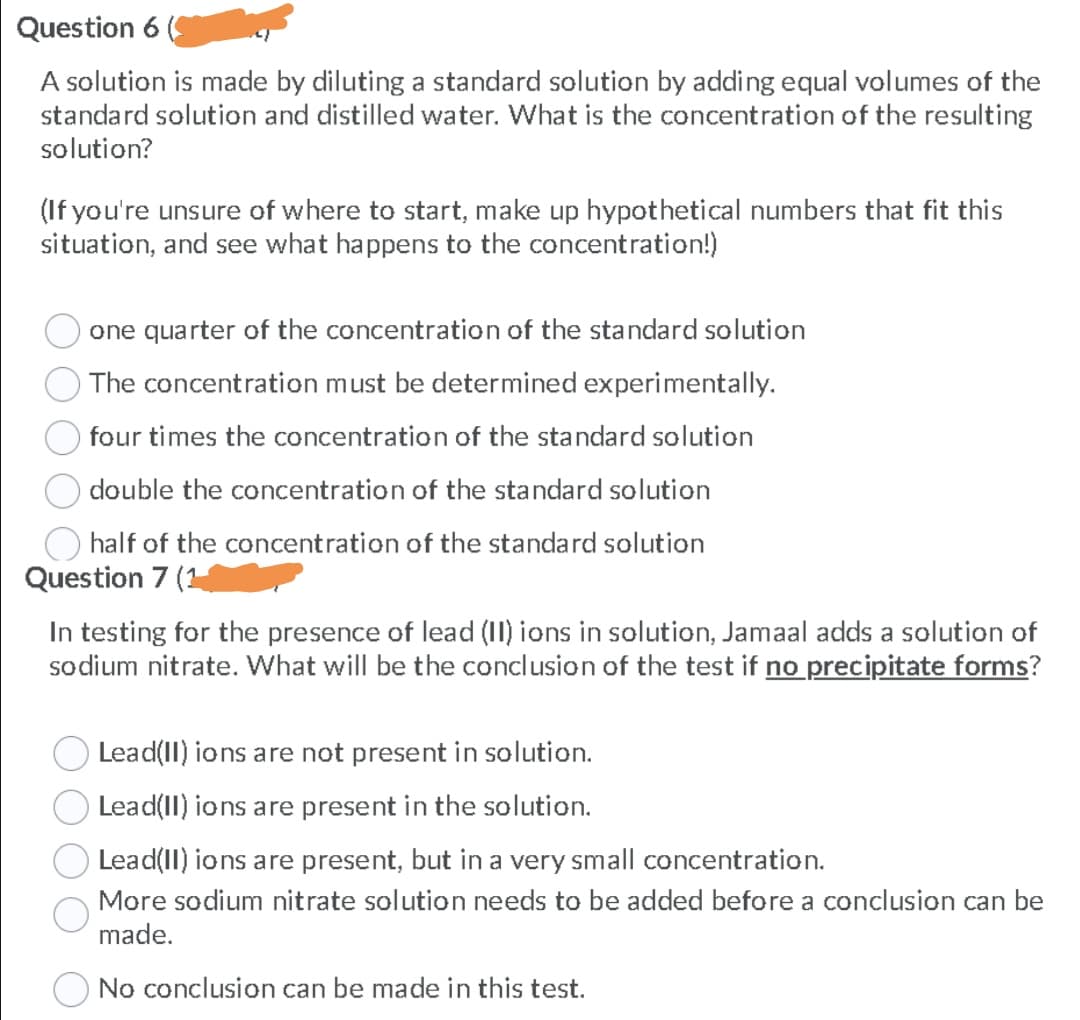A solution is made by diluting a standard solution by adding equal volumes of the standard solution and distilled water. What is the concentration of the resulting solution? (If you're unsure of where to start, make up hypothetical numbers that fit this situation, and see what happens to the concentration!) one quarter of the concentration of the standard solution The concentration must be determined experimentally. four times the concentration of the standard solution double the concentration of the standard solution half of the concentration of the standard solution
A solution is made by diluting a standard solution by adding equal volumes of the standard solution and distilled water. What is the concentration of the resulting solution? (If you're unsure of where to start, make up hypothetical numbers that fit this situation, and see what happens to the concentration!) one quarter of the concentration of the standard solution The concentration must be determined experimentally. four times the concentration of the standard solution double the concentration of the standard solution half of the concentration of the standard solution
Chemistry: Principles and Reactions
8th Edition
ISBN:9781305079373
Author:William L. Masterton, Cecile N. Hurley
Publisher:William L. Masterton, Cecile N. Hurley
Chapter14: Equilibria In Acid-base Solutions
Section: Chapter Questions
Problem 64QAP
Related questions
Question
Pls solve

Transcribed Image Text:Question 6 (9
A solution is made by diluting a standard solution by adding equal volumes of the
standard solution and distilled water. What is the concentration of the resulting
solution?
(If you're unsure of where to start, make up hypothetical numbers that fit this
situation, and see what happens to the concentration!)
one quarter of the concentration of the standard solution
The concentration must be determined experimentally.
four times the concentration of the standard solution
double the concentration of the standard solution
half of the concentration of the standard solution
Question 7 (1
In testing for the presence of lead (II) ions in solution, Jamaal adds a solution of
sodium nitrate. What will be the conclusion of the test if no precipitate forms?
Lead(II) ions are not present in solution.
Lead(II) ions are present in the solution.
Lead(II) ions are present, but in a very small concentration.
More sodium nitrate solution needs to be added before a conclusion can be
made.
No conclusion can be made in this test.
Expert Solution
This question has been solved!
Explore an expertly crafted, step-by-step solution for a thorough understanding of key concepts.
This is a popular solution!
Trending now
This is a popular solution!
Step by step
Solved in 2 steps

Knowledge Booster
Learn more about
Need a deep-dive on the concept behind this application? Look no further. Learn more about this topic, chemistry and related others by exploring similar questions and additional content below.Recommended textbooks for you

Chemistry: Principles and Reactions
Chemistry
ISBN:
9781305079373
Author:
William L. Masterton, Cecile N. Hurley
Publisher:
Cengage Learning

Chemistry
Chemistry
ISBN:
9781305957404
Author:
Steven S. Zumdahl, Susan A. Zumdahl, Donald J. DeCoste
Publisher:
Cengage Learning

Chemistry: An Atoms First Approach
Chemistry
ISBN:
9781305079243
Author:
Steven S. Zumdahl, Susan A. Zumdahl
Publisher:
Cengage Learning

Chemistry: Principles and Reactions
Chemistry
ISBN:
9781305079373
Author:
William L. Masterton, Cecile N. Hurley
Publisher:
Cengage Learning

Chemistry
Chemistry
ISBN:
9781305957404
Author:
Steven S. Zumdahl, Susan A. Zumdahl, Donald J. DeCoste
Publisher:
Cengage Learning

Chemistry: An Atoms First Approach
Chemistry
ISBN:
9781305079243
Author:
Steven S. Zumdahl, Susan A. Zumdahl
Publisher:
Cengage Learning



Introductory Chemistry: A Foundation
Chemistry
ISBN:
9781337399425
Author:
Steven S. Zumdahl, Donald J. DeCoste
Publisher:
Cengage Learning